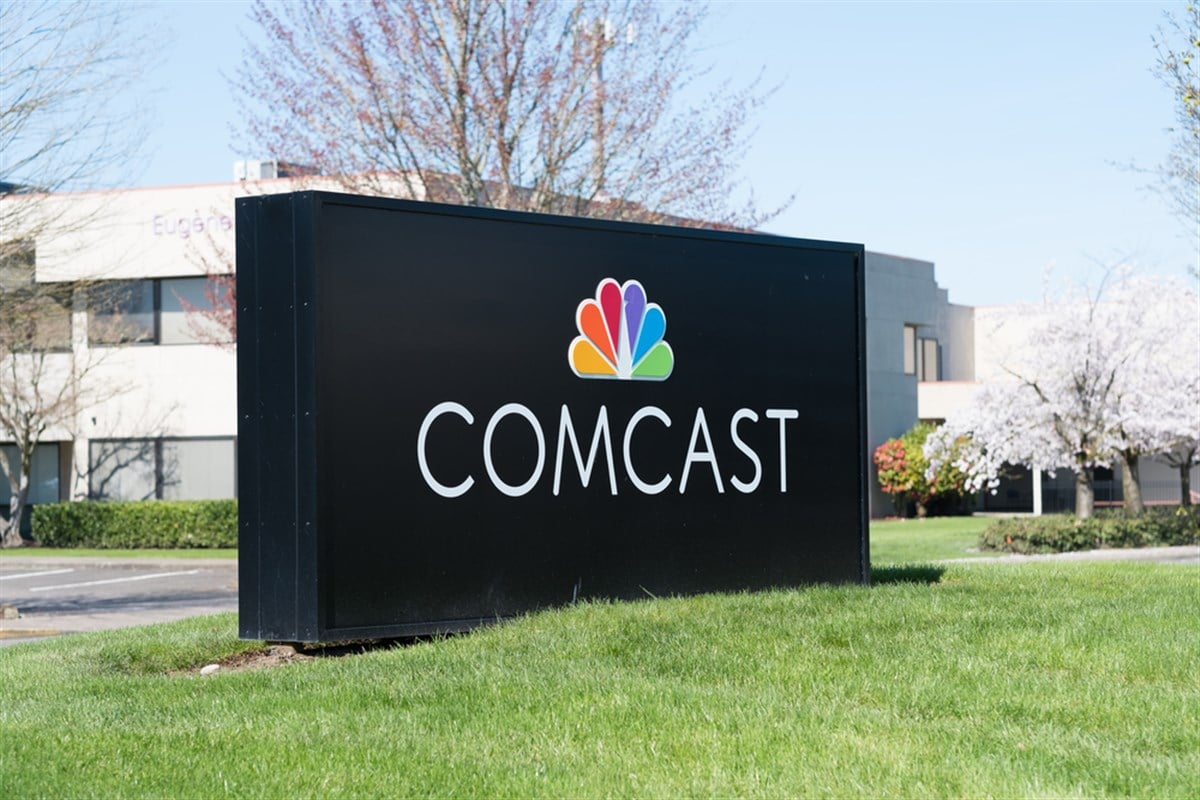Comcast Shares Down 10% in the Last Two Days Despite Q1 Beat

Comcast Corporation (NASDAQ:CMCSA) shares lost more than 10% lower since Wednesday's close, despite the company’s reported Q1 beat, with EPS of $0.86 coming in above the consensus estimate of $0.81. Revenue was $31 billion, compared to the consensus of $30.54 billion.
Analysts at Oppenheimer shared their views on the company’s quarterly results, stating that secular pressure is beginning to impact the core business.
Broadband net adds were a normalized 180,000, down from 538,000 in Q1/20. Video/voice customer net losses of 512,000/283,000, respectively, were substantially worse than Oppenheimer’s estimates of 460,000/150,000 and last year's 248,000/24,000 declines. Price increases, which the analysts see as a negative strategy long term, did drive Cable revenue growth of 4.7% year-over-year to $16.54 billion, beating Oppenheimer’s estimate of $16.34 billion.
Advertising and Wireless remained robust entering 2022. The company added 318,000 wireless lines, the second consecutive record quarterly result, fueling Wireless revenue growth of 32% year-over-year.
| Symbol | Price | %chg |
|---|---|---|
| TLKM.JK | 3100 | 1.29 |
| DNET.JK | 9050 | 0 |
| AMX.BA | 30080 | 0.6 |
| ISAT.JK | 1890 | -0.79 |

Comcast Corporation's Strong Financial Performance in Q2 2025
- Comcast Corporation (NASDAQ:CMCSA) reported adjusted earnings per share (EPS) of $1.25, surpassing the Zacks Consensus Estimate by 6.84%.
- The company's revenues grew by 2.1% year over year, reaching $30.31 billion, driven by strong performances in the Content & Experiences and Business Services segments.
- Peacock subscribers increased by 24.2% year over year to 41 million, contributing to an 18% revenue growth for Peacock, reaching $1.2 billion in the quarter.
Comcast Corporation, trading as NASDAQ:CMCSA, is a major player in the cable and internet industry. On July 31, 2025, Morgan Stanley updated its rating for CMCSA to "Equal-Weight," maintaining a "hold" action. At that time, the stock price was $33.23. This decision comes amidst Comcast's strong financial performance in the second quarter of 2025.
Comcast reported impressive second-quarter results, with adjusted earnings per share (EPS) of $1.25, surpassing the Zacks Consensus Estimate by 6.84%. This marks a 3.3% increase from the previous year. The company's revenues grew by 2.1% year over year, reaching $30.31 billion, exceeding expectations by 1.6%. This growth was driven by strong performances in the Content & Experiences and Business Services segments.
A significant factor in Comcast's success was the increase in Peacock subscribers, which rose by 24.2% year over year to 41 million. This led to an 18% revenue growth for Peacock, reaching $1.2 billion in the quarter. Additionally, the Connectivity & Platforms segment, which accounts for 67.3% of Comcast's revenues, saw a 0.7% year-over-year increase, totaling $20.39 billion.
Comcast's strong performance in its Studios and Theme Parks divisions also contributed to its overall financial success for the quarter. The company's free cash flow more than tripled to $4.5 billion, fueling investor enthusiasm. Despite these strong results, Comcast has not provided guidance for the remainder of the year, leaving analysts potentially surprised.
Shares of Comcast have risen by 2.6% following the company's impressive earnings report. Analysts had anticipated earnings of $1.18 per share on $29.8 billion in sales for the second quarter. However, Comcast exceeded expectations by reporting earnings of $1.25 per share on $30.3 billion in sales. Despite the strong results, earnings are expected to grow by only a penny year over year in the third quarter and to decline in the fourth quarter, which could impact the full-year outlook.

Comcast Corporation (NASDAQ:CMCSA) Overview: A Strong Contender in the Telecommunications Industry
- Comcast Corporation (NASDAQ:CMCSA) has shown a positive trend with a gain of 2.22% over the past month, indicating a favorable direction for investors.
- The stock experienced a slight decline of 0.58% in the last 10 days, potentially offering a buying opportunity for investors.
- With a projected stock price increase of 19.26% and a Piotroski Score of 8 out of 9, CMCSA presents a strong growth potential and financial health.
Comcast Corporation (NASDAQ:CMCSA) is a global media and technology company, operating through various segments, including Cable Communications, Media, Studios, and Theme Parks. As a major player in the telecommunications industry, Comcast competes with giants like AT&T and Verizon. Its diverse operations provide a stable revenue stream, making it a significant entity in the market.
Over the past month, CMCSA has shown a positive trend with a gain of 2.22%. This indicates that the stock is moving in a favorable direction, which can be appealing to investors. However, in the last 10 days, the stock has seen a slight decline of 0.58%. This short-term dip might be an opportunity for investors to buy the stock at a lower price, anticipating a rebound.
CMCSA's growth potential is notable, with a projected increase of 19.26% in stock price. This suggests that the stock is undervalued, offering a chance for growth-oriented investors to benefit from its appreciation. Analysts have set a target price of $41.17, reflecting their confidence in the stock's ability to reach this level soon.
The company's financial health is strong, as evidenced by its Piotroski Score of 8 out of 9. This score indicates that Comcast is financially sound, with good profitability, liquidity, and operational efficiency. Such a high score is reassuring for investors, as it suggests that the company is well-managed and capable of sustaining its operations effectively.

Comcast Tops Profit Forecasts but Broadband Subscriber Loss Sends Shares Sliding
Comcast (NASDAQ:CMCSA) delivered stronger-than-expected earnings and cash flow for the first quarter of 2025, but a sharper-than-anticipated decline in broadband subscribers overshadowed the solid financial results, dragging the stock down more than 3% today.
The company reported earnings of $1.09 per share, well ahead of the $0.99 consensus. Revenue came in at $29.89 billion, narrowly beating analyst estimates. Operating cash flow rose to $8.29 billion, while adjusted EBITDA increased 1.9% year-over-year to $9.53 billion—both topping projections. Free cash flow surged 19% to $5.42 billion, far exceeding the expected $4.06 billion.
Despite these financial beats, investor sentiment turned negative due to continued subscriber erosion in key areas. Comcast lost 199,000 domestic broadband customers—more than the 144,000 expected and nearly triple the loss from the same period last year. The trend raises concerns about market saturation and competitive pressure from fiber and wireless internet alternatives.
The company also recorded a loss of 427,000 video subscribers, slightly worse than forecasts. On a more positive note, wireless additions remained strong, with 323,000 new lines added—beating expectations and rising 12% year-over-year.

Comcast Tops Profit Forecasts but Broadband Subscriber Loss Sends Shares Sliding
Comcast (NASDAQ:CMCSA) delivered stronger-than-expected earnings and cash flow for the first quarter of 2025, but a sharper-than-anticipated decline in broadband subscribers overshadowed the solid financial results, dragging the stock down more than 3% today.
The company reported earnings of $1.09 per share, well ahead of the $0.99 consensus. Revenue came in at $29.89 billion, narrowly beating analyst estimates. Operating cash flow rose to $8.29 billion, while adjusted EBITDA increased 1.9% year-over-year to $9.53 billion—both topping projections. Free cash flow surged 19% to $5.42 billion, far exceeding the expected $4.06 billion.
Despite these financial beats, investor sentiment turned negative due to continued subscriber erosion in key areas. Comcast lost 199,000 domestic broadband customers—more than the 144,000 expected and nearly triple the loss from the same period last year. The trend raises concerns about market saturation and competitive pressure from fiber and wireless internet alternatives.
The company also recorded a loss of 427,000 video subscribers, slightly worse than forecasts. On a more positive note, wireless additions remained strong, with 323,000 new lines added—beating expectations and rising 12% year-over-year.

Comcast Corporation's Financial Overview and Market Challenges
- Earnings Per Share (EPS) of $0.96, surpassing estimates.
- Revenue reached approximately $31.92 billion, exceeding expectations.
- Increased quarterly dividend by 6.5% despite subscriber losses.
Comcast Corporation, listed as NASDAQ:CMCSA, is a major player in the telecommunications and media industry. It offers services like cable television, internet, and phone services, and owns NBCUniversal, which produces and distributes entertainment content. Comcast competes with companies like AT&T and Charter Communications in the telecommunications sector.
On January 30, 2025, Comcast reported earnings per share (EPS) of $0.96, surpassing the estimated $0.862. This positive performance was accompanied by revenue of approximately $31.92 billion, exceeding the estimated $31.61 billion. Despite these strong financial results, the stock is experiencing a decline, as highlighted by Barrons.
Comcast's Content & Experiences division saw a 3.5% revenue increase to $7.2 billion, driven by growth in the Media segment. The Studios unit reported an 85% year-over-year increase in EBITDA and a 7% rise in revenue to $3.27 billion, thanks to successful films like Wicked and The Wild Robot, as noted by Deadline.
Despite the positive earnings report, Comcast faces challenges with ongoing subscriber losses. To reward shareholders, the company increased its quarterly dividend by 6.5%, bringing it to 8 cents per share. This move aims to maintain investor confidence amid subscriber challenges, as reported by MarketWatch.
Comcast's financial metrics provide insight into its market valuation. The company has a price-to-earnings (P/E) ratio of approximately 9.83 and a price-to-sales ratio of about 1.16. Its enterprise value to sales ratio is around 1.91, and the enterprise value to operating cash flow ratio is approximately 9.22. The debt-to-equity ratio is about 1.18, indicating financial leverage, while the current ratio of 0.72 suggests potential liquidity challenges.

Comcast Corporation's Financial Overview and Market Challenges
- Earnings Per Share (EPS) of $0.96, surpassing estimates.
- Revenue reached approximately $31.92 billion, exceeding expectations.
- Increased quarterly dividend by 6.5% despite subscriber losses.
Comcast Corporation, listed as NASDAQ:CMCSA, is a major player in the telecommunications and media industry. It offers services like cable television, internet, and phone services, and owns NBCUniversal, which produces and distributes entertainment content. Comcast competes with companies like AT&T and Charter Communications in the telecommunications sector.
On January 30, 2025, Comcast reported earnings per share (EPS) of $0.96, surpassing the estimated $0.862. This positive performance was accompanied by revenue of approximately $31.92 billion, exceeding the estimated $31.61 billion. Despite these strong financial results, the stock is experiencing a decline, as highlighted by Barrons.
Comcast's Content & Experiences division saw a 3.5% revenue increase to $7.2 billion, driven by growth in the Media segment. The Studios unit reported an 85% year-over-year increase in EBITDA and a 7% rise in revenue to $3.27 billion, thanks to successful films like Wicked and The Wild Robot, as noted by Deadline.
Despite the positive earnings report, Comcast faces challenges with ongoing subscriber losses. To reward shareholders, the company increased its quarterly dividend by 6.5%, bringing it to 8 cents per share. This move aims to maintain investor confidence amid subscriber challenges, as reported by MarketWatch.
Comcast's financial metrics provide insight into its market valuation. The company has a price-to-earnings (P/E) ratio of approximately 9.83 and a price-to-sales ratio of about 1.16. Its enterprise value to sales ratio is around 1.91, and the enterprise value to operating cash flow ratio is approximately 9.22. The debt-to-equity ratio is about 1.18, indicating financial leverage, while the current ratio of 0.72 suggests potential liquidity challenges.

Comcast Corporation (NASDAQ:CMCSA) Overview and Financial Performance
- David Joyce from Seaport Global set a price target of $46 for Comcast Corporation (NASDAQ:CMCSA), indicating a potential upside of 16.37%.
- Comcast closed the trading day at $39.71, a 0.46% increase, but showed volatility within a narrow trading range.
- The company has a market capitalization of approximately $151.58 billion, highlighting its significant presence in the media and technology sectors.
Comcast Corporation (NASDAQ:CMCSA) is a global media and technology company, operating through segments like Cable Communications, Media, Studios, and Theme Parks. Competing with giants such as AT&T and Disney, Comcast is a major player in the industry. On December 11, 2024, David Joyce from Seaport Global set a price target of $46 for CMCSA, suggesting a potential price increase of 16.37% from its current price of $39.53.
Recently, Comcast closed the trading day at $39.71, marking a 0.46% increase from its previous closing price. Despite this gain, the stock underperformed compared to the broader market. The stock traded between $39.42 and $39.84 during the day, showing some volatility within a narrow range.
Over the past year, Comcast's stock has seen a high of $47.11 and a low of $36.43. This range indicates some fluctuations in investor sentiment and market conditions. With a market capitalization of approximately $151.58 billion, Comcast remains a significant player in the media and technology sectors.
The trading volume for the day was 23,447,891 shares, reflecting active investor interest. This level of trading activity can influence the stock's price movements and liquidity. As investors consider the price target set by David Joyce, they may weigh these factors in their investment decisions.







